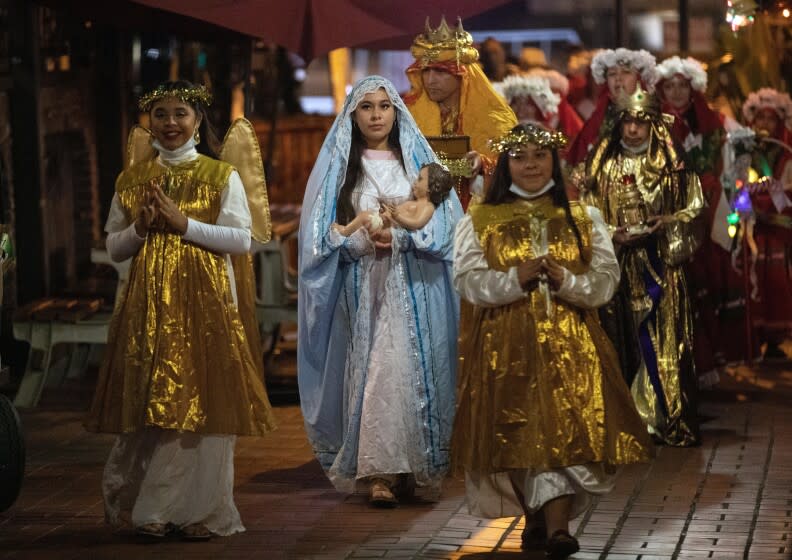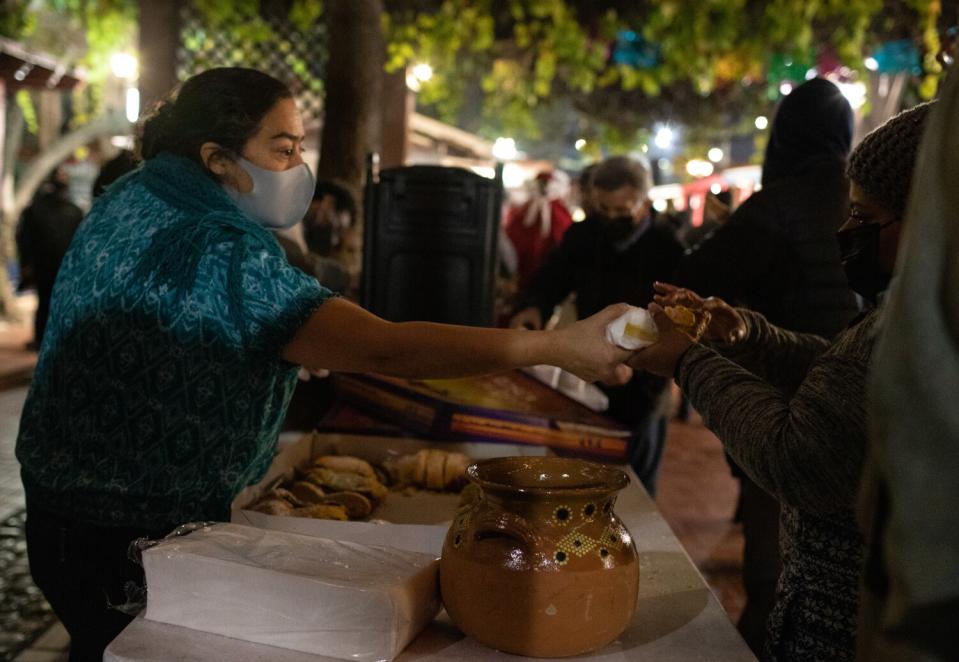Some Angelenos say it's time to learn to live with COVID

As coronavirus cases soared across Los Angeles last week, Jennifer Chan entered Olvera Street’s Casa California in search of the colorful and decorative papel picado for her baby shower.
“I wanted something that said ‘California’ for the party,” said Chan, 28, a La Mirada resident who is six months pregnant and whose East Coast family was flying in for the event. “Plus, I really wanted to get out of the house for a change.”
Chan, who works as a computer programmer, has generally been extremely cautious throughout the pandemic — getting vaccinated and boosted as soon as she was eligible and leaving her home as little as possible.
But recently she’s longed for the normalcy of her pre-pandemic life.
A few months ago she agreed to allow a close friend to throw her an in-person baby shower, and over the last two weeks she’s ventured into a grocery store and even dined at two restaurants.
“I’m about to go through my own lockdown once this baby comes,” said Chan, pointing to her stomach. “So, I’m going to be safe absolutely, but I’m also going to enjoy this time and being on my feet while I can.”
She's not alone.

As the Omicron variant infects record numbers of people across California and the nation, many in Southern California say they are no longer willing to hide from a virus that has already killed 800,000 Americans.
Instead, they're ready to live with it.
This may not be a catastrophe.
Epidemiological evidence suggests that while the Omicron variant is much more contagious than previous versions of SARS-CoV-2, it is also significantly less lethal.
In a fairytale scenario, Omicron would burn through the U.S. population, perhaps requiring a few days of sick leave from those it infects, but also imparting immunity to tens of millions and ending the pandemic here for good.
It almost seems reasonable, but experts say the end of the pandemic is unlikely to be that simple, or come that fast.
“I think of this time as a transition,” said Georges Benjamin, executive director of the American Public Health Assn. “The virus is transitioning, and as a society we are transitioning and learning to live with it.”
The end of the pandemic is likely to be a gradual process, said Chunhuei Chi, director of the Center for Global Health at Oregon State University. Ultimately, it will require us to establish a relationship with SARS-CoV-2 that mirrors our relationship with the virus that causes seasonal flu.
That means getting a shot once a year to prevent the most severe symptoms of COVID-19, and understanding that if you get infected anyway you might feel miserable for a few days, but you are unlikely to end up in the hospital or worse.
“We want to get to a place where we are no longer concerned about preventing infections, but instead, worried about preventing severe symptoms and death,” Chi said.
It might almost feel like we’re there now, but scientists say we're not.
Tun-Hou Lee, professor emeritus of virology at Harvard's T.H. Chan School of Public Health, notes that the mortality rate of SARS-CoV-2 (254 deaths per 100,000 people) is still far higher than that of influenza (1.8 deaths per 100,000 people).
"Even if one believes that the mortality rate of 254 per 100,000 will be lower once most of the U.S. population is 'fully' vaccinated, my bias is that SARS-CoV-2 infection will have a higher mortality rate than flu," he said.
To further reduce the risk of hospitalizations and deaths from the coronavirus, Chi said he'd like to see new vaccines become available that are better at preventing infections and provide longer-lasting immunity, as well as more effective drug treatments for those who are infected. Both are already in the works, he said. The widespread immunity that will likely be imparted by Omicron will also help — even if it’s fleeting.
“I am quite hopeful that with all these factors together, by the fall we may see the pandemic ending and turning into a flu-like endemic, at least in North America,” Chi said.
In the meantime, life in Southern California goes on.
In-person classes were back in session Thursday at Leimert Park’s Nicholas Dance Studio after a two-week break, but with a whole lot of safeguards firmly in place.
Studio owner Cathie Nicholas had enclosed the viewing area for parents in plexiglass and limited capacity to three people. The studio’s floor is disinfected twice a week, hand-sanitizing stations abound, and a negative coronavirus test, a temperature check and a mask are all required for entry.
“My belief is we’ve made all the adjustments here and we’re just kind of rolling with the punches,” said Nicholas. “It hasn’t been easy, but we have to get out and live.”
On Thursday evening, 200 spectators participated in the annual Olvera Street Three Kings procession. The three wise men, a pair of angels, the holy family and a slew of shepherds along with visitors completed a lap and a half around Olvera Street.
The annual event, which started in the 1970s, ended with the distribution of rosca de reyes Mexican sweet bread and champurrado.
The procession was canceled in 2021 because of COVID-19.

“We had a lot of interest from the community to have this back,” said Valerie Hanley, 53, Casa California owner and treasurer of the Olvera Street Merchants Assn. Foundation. “And I think we were able to do it because we’ve done everything we could to make it as safe as possible.”
Marchers were masked and most spread out while eating and drinking that night.
“There comes a point where you have to get back to being with families and visitors and customers,” Hanley said. “It’s important.”
El Sereno Wilson High School senior Donna Arce, who played the Virgin Mary, said she was encouraged by the crowd’s willingness to mask up and march.
“People have been scared for a while, so it’s nice to see a good crowd,” she said. “A lot of people have followed the steps, like getting vaccinated and being masked, so we should continue this tradition.”
This story originally appeared in Los Angeles Times.

